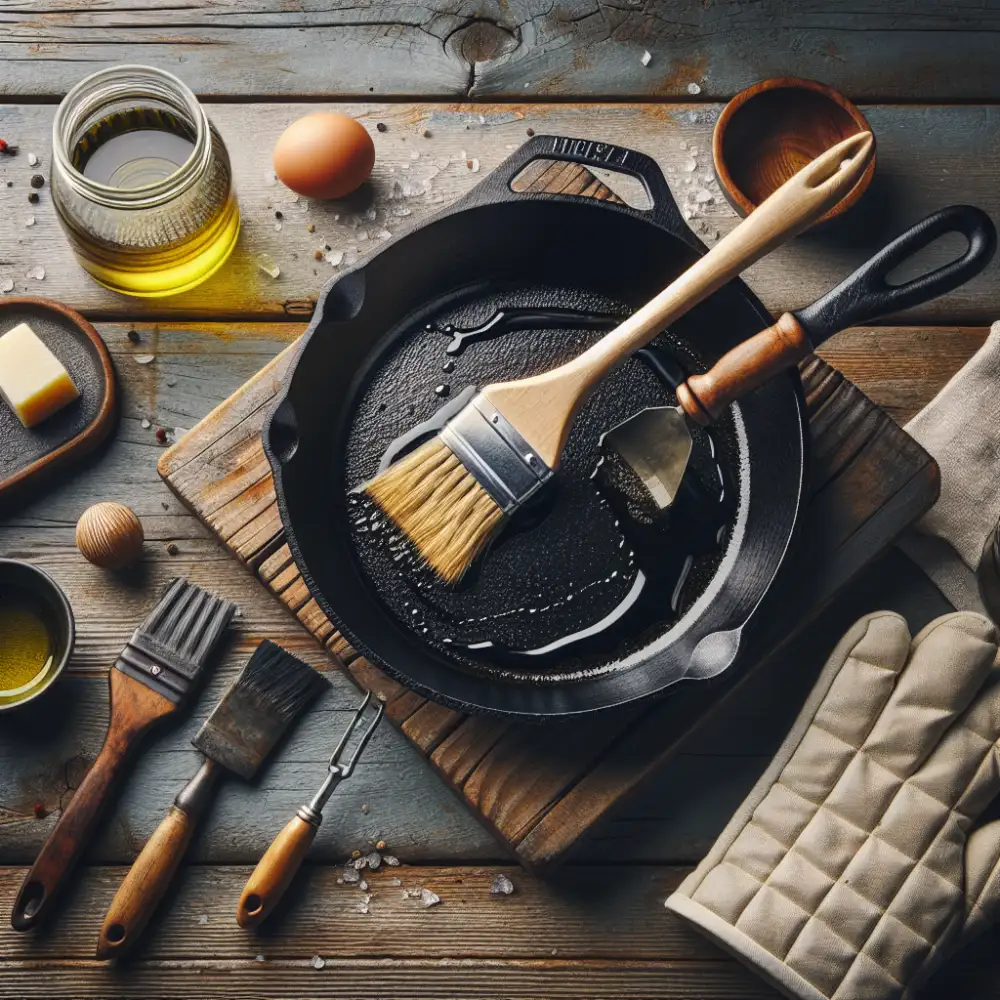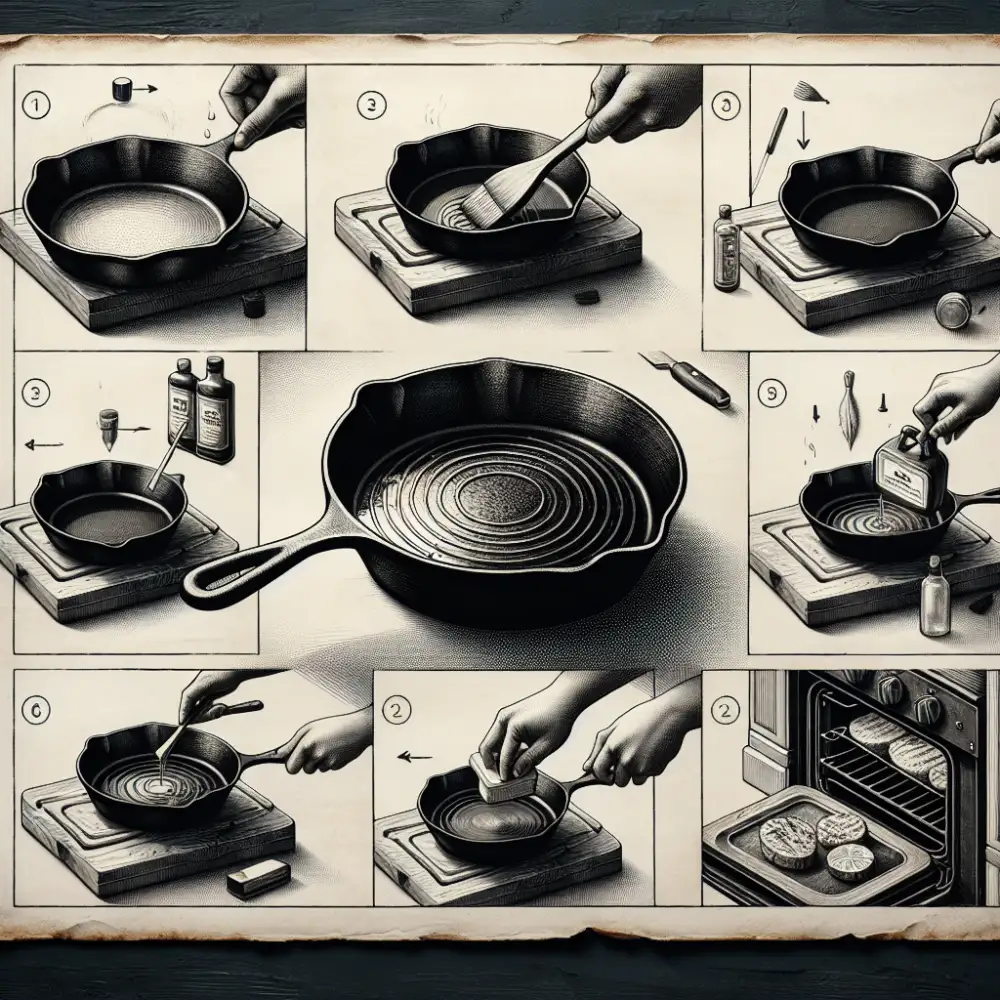Mastering the Art of Seasoning: A Step-by-Step Guide to Season Your Cast Iron Skillet

- Importance of seasoning for cast iron skillets
- Preparing the cast iron skillet for seasoning
- Choosing the right oil for seasoning
- Step-by-step guide to seasoning a cast iron skillet
- Cleaning the skillet thoroughly
- Applying a thin layer of oil
- Heating the skillet
- Allowing the oil to polymerize
- Repeating the seasoning process
- Caring for a seasoned cast iron skillet
- Cleaning after each use
- Avoiding harsh cleaning agents
- Maintaining the seasoning regularly
- Common mistakes to avoid when seasoning a cast iron skillet
- Tips and tricks for achieving a perfect seasoning
Seasoning a cast iron skillet is an essential step in maintaining its durability and enhancing its cooking performance. Cast iron skillets have been used for centuries due to their excellent heat retention and even distribution. However, they require regular seasoning to create a non-stick surface and prevent rusting. In this article, we will explore the importance of seasoning, the steps involved in the process, and tips for caring and maintaining a well-seasoned cast iron skillet. By mastering the art of seasoning, you can elevate your culinary creations to new heights.
Importance of seasoning for cast iron skillets
Seasoning is a crucial step in maintaining and enhancing the performance of your cast iron skillet. When properly seasoned, the skillet develops a natural non-stick surface that prevents food from sticking and provides even heat distribution. This not only improves the cooking experience but also helps to preserve the longevity of the skillet. Seasoning also creates a protective layer that prevents rust and corrosion, ensuring that your skillet stays in top condition for years to come. Additionally, a well-seasoned cast iron skillet adds depth and flavor to your dishes, making them truly delicious. So, don't underestimate the importance of seasoning – it's an essential part of mastering the art of cooking with cast iron.
Preparing the cast iron skillet for seasoning
Before seasoning your cast iron skillet, it is crucial to prepare it properly. Start by washing the skillet with warm water and a mild dish soap to remove any dirt or residue. Use a sponge or brush to scrub the surface gently. Avoid using abrasive materials that can damage the skillet's seasoning.
Once clean, rinse the skillet thoroughly and dry it completely using a towel or by placing it on low heat on the stovetop. Ensure that there is no moisture left on the surface as this can lead to rusting.
Next, inspect the skillet for any signs of rust or rough patches. If you notice any, use steel wool or sandpaper to gently remove them until the surface becomes smooth again. This step is essential for achieving a smooth and even seasoning.
After preparing your cast iron skillet, you are now ready to move on to choosing the right oil for seasoning.
Choosing the right oil for seasoning
Choosing the right oil for seasoning is crucial to achieve a well-seasoned cast iron skillet. It is recommended to use oils with high smoke points, such as vegetable oil, canola oil, or flaxseed oil. These oils can withstand high temperatures without breaking down and forming a sticky residue on the skillet's surface. Avoid using oils with low smoke points, like olive oil or butter, as they can create a sticky and uneven seasoning layer. Additionally, it is important to choose oils that are flavorless and odorless to prevent any undesirable tastes or smells in your food.

Step-by-step guide to seasoning a cast iron skillet
1. Start by cleaning the skillet thoroughly. Scrub it with hot water and a stiff brush to remove any dirt or residue.
2. Once clean, dry the skillet completely to prevent rusting.
3. Choose the right oil for seasoning. Opt for oils with a high smoke point, such as vegetable oil, canola oil, or flaxseed oil.
4. Apply a thin layer of oil all over the skillet, including the handle and exterior surfaces.
5. Preheat your oven to 350°F (175°C). Place the oiled skillet upside down on the oven rack to catch any drips.
6. Bake the skillet for one hour to allow the oil to polymerize and create a non-stick surface.
7. After an hour, turn off the oven and let the skillet cool inside before removing it.
8. Repeat this seasoning process 2-3 times for optimal results, ensuring each layer is thin and even.
Remember, patience is key when seasoning a cast iron skillet. The more you season it, the better it becomes at retaining heat and preventing food from sticking.
| Method | Time | Durability | Ease of Application |
|---|---|---|---|
| Oven Seasoning (Flaxseed Oil) | 1 hour + cooling | High | Medium |
| Stovetop Seasoning (Vegetable Oil) | 30-45 minutes + cooling | Medium | Easy |
Cleaning the skillet thoroughly
To start the seasoning process, it is crucial to clean the cast iron skillet thoroughly. This step ensures that any dirt, rust, or residue is removed before applying the oil. Begin by scrubbing the skillet with hot water and a stiff brush or sponge. Avoid using soap as it can strip away the skillet's natural oils. If there are stubborn food particles, you can use coarse salt as a gentle abrasive. Rinse the skillet thoroughly and dry it completely with a towel to prevent any moisture from causing rust.
Applying a thin layer of oil
Applying a thin layer of oil is a crucial step in seasoning your cast iron skillet. The oil acts as a protective barrier, preventing rust and creating a non-stick surface. To start, choose an oil with a high smoke point such as vegetable oil, canola oil, or flaxseed oil. Using a paper towel or cloth, apply a small amount of oil to the entire surface of the skillet, including the handle and sides. Make sure to coat it evenly and remove any excess oil. This thin layer will help build up the seasoning over time and ensure optimal performance of your cast iron skillet.
Heating the skillet
Heating the skillet is a crucial step in the seasoning process. After applying a thin layer of oil, place the skillet on a stovetop burner set to medium heat. Allow the skillet to heat up gradually for about 10 minutes. This will help the oil penetrate into the pores of the cast iron and create a strong bond with the surface. Heating also helps to evaporate any excess moisture, preventing rust formation. Be sure to handle the hot skillet with oven mitts or a towel to avoid burns.

Allowing the oil to polymerize
Once the cast iron skillet has been heated and coated with oil, it is important to allow the oil to polymerize. This process occurs when the oil reacts with the heat, forming a durable and non-stick surface on the skillet. To achieve this, it is recommended to heat the skillet at a high temperature for about an hour. This allows the oil to bond with the iron, creating a smooth and seasoned finish. During this time, it is important not to disturb or move the skillet as it may disrupt the polymerization process. Once the oil has polymerized, you can remove the skillet from heat and allow it to cool naturally before using or storing it.
Repeating the seasoning process
Repeating the seasoning process is crucial to build up a strong and long-lasting seasoning on your cast iron skillet. After the initial seasoning, it is recommended to repeat the process several times to enhance the non-stick properties and improve the overall performance of the skillet. Each time you season, make sure to clean the skillet thoroughly, apply a thin layer of oil, heat it, and allow the oil to polymerize. This repeated process helps to create a durable and smooth surface that will protect your skillet from rusting and ensure optimal cooking results.
Caring for a seasoned cast iron skillet
Caring for a seasoned cast iron skillet is essential to maintain its non-stick surface and prolong its lifespan. After each use, it is crucial to clean the skillet thoroughly with hot water and a gentle brush or sponge. Avoid using soap or harsh cleaning agents as they can strip away the seasoning. Instead, opt for natural cleaning methods.
To remove stubborn food residue, you can sprinkle coarse salt onto the skillet and scrub gently. Rinse with hot water and dry thoroughly to prevent rusting. It's important to note that while cast iron is durable, it is prone to rust if not properly dried.
To maintain the seasoning, it's recommended to apply a thin layer of oil after each use. This helps replenish any oil that may have been removed during cooking. Simply rub a small amount of oil onto the skillet's surface using a paper towel or cloth.
Regular maintenance is key in preserving the seasoning of your cast iron skillet. If you notice any signs of wear or unevenness in the seasoning, it may be necessary to re-season the skillet. This can be done by repeating the step-by-step guide mentioned earlier.


By following these care instructions, you can enjoy the benefits of a well-seasoned cast iron skillet for years to come. Its non-stick properties will improve over time, making it an indispensable tool in your kitchen arsenal.
Cleaning after each use
Cleaning after each use is an essential step in maintaining a well-seasoned cast iron skillet. After cooking, allow the skillet to cool down slightly before cleaning. Avoid using soap or harsh cleaning agents, as they can strip away the seasoning. Instead, use a brush or sponge with hot water to gently scrub away any food residue. For stubborn stuck-on bits, you can also use coarse salt as a natural abrasive. Once clean, dry the skillet thoroughly to prevent rusting. Remember, proper cleaning ensures that your cast iron skillet stays in great condition for years to come.
Avoiding harsh cleaning agents
When caring for a seasoned cast iron skillet, it is important to avoid using harsh cleaning agents. These can strip away the seasoning and damage the skillet's surface. Instead, opt for gentle cleaning methods such as using hot water and a stiff brush or a non-abrasive sponge to remove any food residue. If necessary, a small amount of mild dish soap can be used, but be sure to rinse it thoroughly afterwards. Avoid soaking the skillet in water for extended periods of time as this can cause rusting. By avoiding harsh cleaning agents, you can preserve the seasoning and prolong the lifespan of your cast iron skillet.
Maintaining the seasoning regularly
Maintaining the seasoning of your cast iron skillet is essential to ensure its longevity and optimal cooking performance. After each use, it's important to clean the skillet properly by using hot water and a gentle brush or sponge. Avoid using harsh cleaning agents as they can strip away the seasoning.
Once cleaned, make sure to dry the skillet thoroughly to prevent any moisture from causing rust. To maintain the seasoning, it's recommended to apply a thin layer of oil after each use. This helps to replenish the protective coating and prevent any potential rusting.
Regularly using your cast iron skillet also helps in maintaining its seasoning. The more you cook with it, the better seasoned it becomes. However, if you notice any signs of deterioration in the seasoning, such as food sticking or a dull appearance, it may be time for re-seasoning.


By following these simple maintenance steps, you can enjoy the benefits of a well-seasoned cast iron skillet for years to come.
Common mistakes to avoid when seasoning a cast iron skillet
1. Using too much oil: Applying excessive oil can lead to a sticky and uneven coating on the skillet. Remember, a thin layer is all you need for effective seasoning.
2. Not cleaning the skillet properly: Before seasoning, make sure to remove any food residue or rust from the skillet. Failing to do so can prevent the oil from adhering properly, resulting in an ineffective seasoning.
3. Using the wrong oil: Not all oils are suitable for seasoning cast iron skillets. Avoid using oils with low smoke points, such as olive oil, as they can create a sticky residue when heated. Opt for oils with high smoke points like vegetable oil or flaxseed oil instead.
4. Skipping the heating process: Heating the skillet before applying the oil helps open up its pores, allowing better absorption of the oil. Skipping this step can result in poor adhesion and an unevenly seasoned surface.
5. Applying too many layers at once: It's important to season in thin layers and build up gradually over time. Applying multiple thick layers at once can lead to a gummy or tacky finish that is difficult to remove.
6. Neglecting regular maintenance: Seasoning is not a one-time process; it requires regular upkeep. Failing to maintain the seasoning by not reapplying oil or cleaning properly after each use can cause it to deteriorate over time.
By avoiding these common mistakes, you can ensure that your cast iron skillet is properly seasoned and ready to deliver exceptional cooking results for years to come.
Tips and tricks for achieving a perfect seasoning
1. Use a high smoke point oil: Opt for oils with high smoke points like vegetable oil, canola oil, or flaxseed oil. These oils can withstand the high heat required for seasoning without breaking down.
2. Apply multiple thin layers: Instead of applying one thick layer of oil, it's better to apply multiple thin layers. This allows each layer to polymerize properly and creates a more durable seasoning.
3. Heat the skillet gradually: When heating the skillet, start with low heat and gradually increase it. This helps the oil to evenly distribute and bond with the surface of the skillet.
4. Be patient: Seasoning takes time and patience. It's recommended to repeat the seasoning process several times before using your cast iron skillet for cooking. Each layer adds to the strength and non-stick properties of the seasoning.

5. Avoid overheating: While heating the skillet, make sure not to overheat it as this can cause the oil to burn and create a sticky residue on your skillet.
6. Store properly: After each use, make sure your cast iron skillet is completely dry before storing it to prevent any moisture from damaging the seasoning.
7. Regularly maintain the seasoning: To keep your cast iron skillet in top condition, periodically reapply a thin layer of oil and heat it for a short period of time to maintain its non-stick properties.
By following these tips and tricks, you'll be able to achieve a perfect seasoning on your cast iron skillet, ensuring that it becomes a versatile tool in your kitchen that lasts for generations.
Mastering the art of seasoning your cast iron skillet is essential for unlocking its full potential. By following the step-by-step guide, you can create a non-stick surface that enhances the flavor and texture of your dishes. A well-seasoned skillet also provides excellent heat retention and distribution, ensuring even cooking.
The benefits of a seasoned cast iron skillet extend beyond the kitchen. With proper care, it can last for generations, becoming a cherished heirloom. Additionally, cooking with a seasoned skillet reduces the need for excessive oil or butter, making it a healthier option.
So, take the time to season your cast iron skillet correctly and maintain its seasoning regularly. With each use, you'll notice an improvement in its performance and enjoy delicious meals that are cooked to perfection. Embrace the timeless tradition of seasoning and elevate your culinary creations to new heights with a well-seasoned cast iron skillet.
Published: 10. 02. 2024
Category: Food



